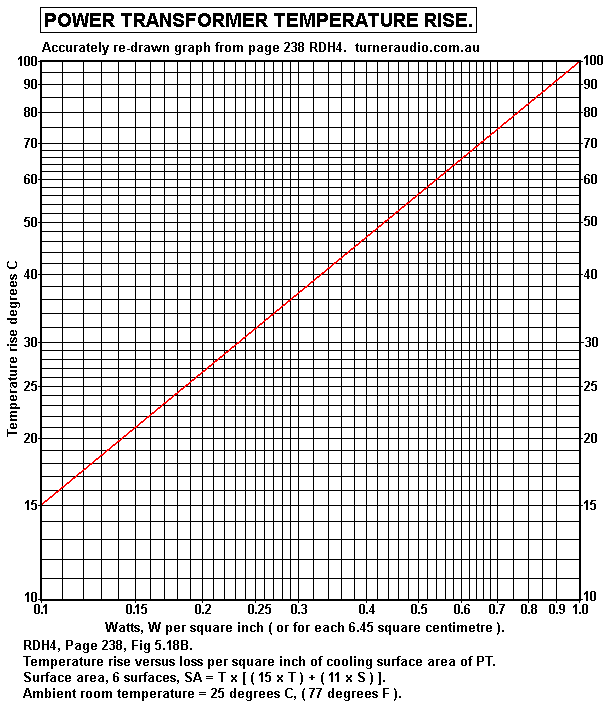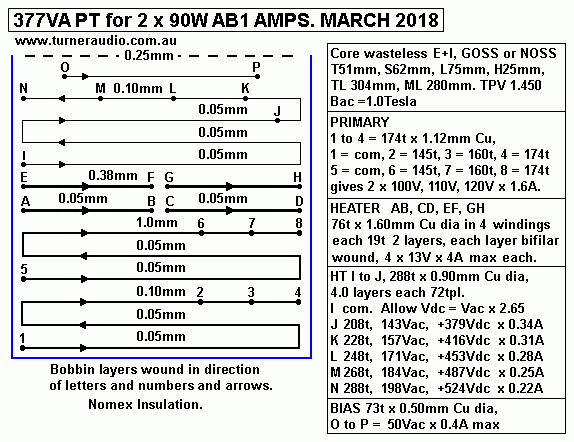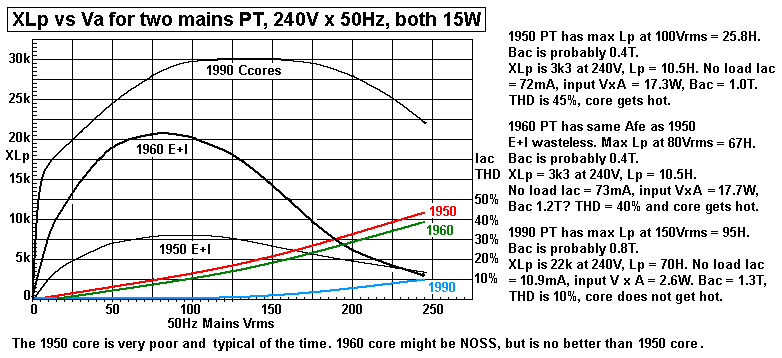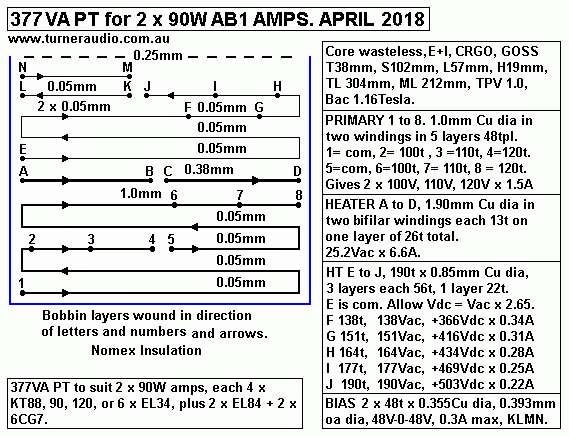
| L mm |
H mm |
Window area |
Max bobbin content height 0.8 x H |
Insulation layers = 0.1 x H + bobbin base 2mm |
All wire ht including enamel insulation |
Bobbin wind width = L - ( 2 x 2mm) |
Area occupied by all wire |
Copper section Area Cu per LxH |
| 76.2 |
25.4 |
1,935 sq.mm |
20.32mm | 2.5mm + 2.0mm |
15.82mm |
72.2mm |
1,142sq.mm |
0.388 |
| 66.6 |
22.2 |
1,478 sq.mm |
17.76mm | 2.2mm + 2.0mm |
13.56mm |
62.6mm |
849sq.mm |
0.378 |
| 57.1 |
19.05 | 1,088 sq.mm |
15.24mm | 1.9mm + 2.0mm |
11.4mm |
53.1mm |
605sq.mm |
0.366 |
| 47.6 |
15.8 | 756 sq.mm |
12.64mm | 1.6mm + 2.0mm |
9.1mm |
43.6mm |
396sq.mm |
0.345 |

| CRGO, GOSS M4, M5, M6 | 1.7T |
1.5T |
1.2T |
1.1T |
1.0T |
0.9T |
0.8T |
| Heat Loss
per Kg |
2.2W |
1.0W |
0.6W |
0.51W |
0.42W |
0.37W |
0.27W |
| NOSS M13 |
1.7T |
1.5T |
1.2T |
1.1T |
1.0T |
0.9T |
0.8T |
| Heat Loss
per Kg |
3.3W |
2.7W |
1.4W |
1.2W |
1.0W |
0.8W |
0.7W |






| Ea = Vdc anode to cathode, KT120. B+ at OPT CT = Ea for fixed bias, approx |
360 360 |
400 400 2 |
440 440 489 |
480 480 536 |
520 520 583 |
| Idle Pda+g2, each KT120, W |
40 |
40 |
40 |
40 |
40 |
| Idle Pda+g2, 4 x KT120, W |
160 |
160 |
160 |
160 |
160 |
| Idle Ia+g2, ea KT120, mAdc |
110 |
100 |
90 |
80 |
70 |
| Idle Ia+g2, 4 x KT120, mAdc |
440 |
400 |
360 |
320 |
280 |
| Vac for HT winding, Vrms approx |
140 |
155 |
170 |
185 |
200 |
| Pdc from PSU at max Idc, W | 160 |
160 |
160 |
160 |
160 |
| Idle Iac for HT winding, Arms |
1.24 |
1.13 |
1.02 |
0.90 |
0.80 |
| Class A Po max, One channel, W | 34 |
35 |
36 |
37 |
37 |
| B+ at OPT CT = Ek + Ea for cathode bias approx Ea = Vdc from abode to cathode. |
395 |
442 |
489 |
536 |
583 |
| Idle Pda+g2, each KT120, W |
40 |
40 |
40 |
40 |
40 |
| Idle Pda+g2, 4 x KT120, W |
160 |
160 |
160 |
160 |
160 |
| Idle Idc, ea KT120, mAdc | 110 |
100 |
90 |
80 |
70 |
| Idle Idc, 4 x KT120, mAdc | 440 |
400 |
360 |
320 |
280 |
| Vac for HT winding, Vrms approx | 152 |
170 |
188 |
206 |
224 |
| Pdc from PSU at max Idc, W | 175 |
176 |
176 |
174 |
165 |
| Idle Iac for HT winding, Arms |
1.24 |
1.13 |
1.02 |
0.90 |
0.80 |
| Class A Po max, One channel, W |
34 |
35 |
36 |
37 |
38 |
| B+ at OPT CT = Ea, fixed bias only | 360 |
400 |
440 |
480 |
520 |
| Idle Pda+g2, each KT120, W | 28 |
28 |
28 |
28 |
28 |
| Idle
Pda+g2, 4 x KT120, W |
112 |
112 |
112 |
112 |
112 |
| Idle Idc, each KT120, mAdc | 77 |
70 |
63 |
58 |
53 |
| Max Ia+g2, AB1, each KT120, mAdc |
150 |
150 |
140 |
130 |
120 |
| Max Ia+g2, 4 x KT120, mAdc | 610 |
600 |
570 |
540 |
520 |
| Vac for HT winding, Vrms approx | 140 |
155 |
170 |
185 |
200 |
| Pdc from PSU at max Idc, W |
220 |
240 |
250 |
260 |
270 |
| Max Iac HT winding, at max Idc Arms | 1.7 |
1.7 |
1.6 |
1.5 |
1.5 |
| Class AB Po max, 2 Channels, W | 90 |
100 |
110 |
130 |
150 |